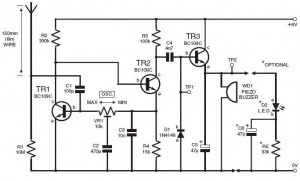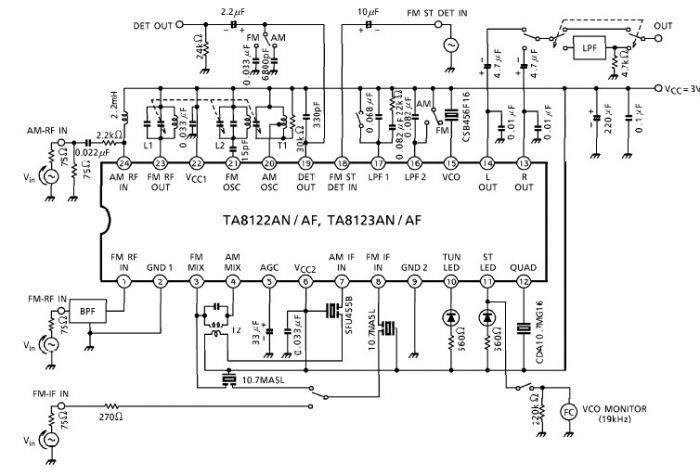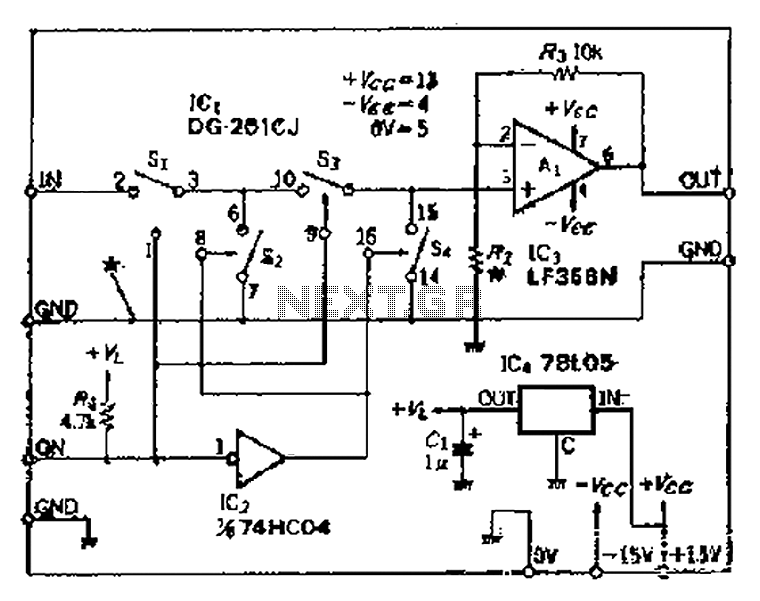
Simple Lightning Detector Circuit

This do-it-yourself lightning detector circuit is a highly sensitive continuous electricity detector that can provide an early warning of approaching storms from inter-cloud discharges prior to an earth-to-sky lightning strike occurring. An aerial antenna made of a short length of wire detects storms within a two-mile radius. The circuit emits an audible warning sound from a piezo buzzer or flashes an LED for each discharge detected, providing advance notice of impending storms so that precautions may be taken. A primary feature of the lightning detector is its ability to be set to self-oscillation, with its stability optimized through the resistor values specified in the circuit diagram. The oscillator is DC coupled, and feedback is applied through the collector of transistor TR1 to the base of transistor TR2, while the overall gain configuration is set using the multiturn (12, 18, or 22) preset resistor VR1. To create the lightning sensor, adjust preset VR1 for oscillation by monitoring test point TP1, which should be approximately 7 volts peak-to-peak. Test point TP2 should read +6V DC. After this, fine-tune VR1 again to cease oscillation; use a screwdriver to briefly touch the high side of capacitor C1 a few times; the tone should sound for one or two seconds and then stop. If it continues, make a very slight adjustment and recheck. Another method is to electrostatically charge a plastic ruler and then bring your finger close to discharge, about two inches away from the antenna. Powered by a nine-volt battery, the lightning detector circuit consumes about 600 µA in standby. When activated, the current will increase to 4 mA based on the low current sounder WD1. A minimum three-volt supply is required for optimal performance, which will create a pinging sound to alert in real-time of any electrostatic discharge activity.
The lightning detector circuit operates on the principle of detecting the electric fields generated by thunderstorms. The design incorporates a simple yet effective oscillator circuit that uses two transistors (TR1 and TR2) to amplify the signals received from the antenna. The antenna, typically a short wire, captures the electromagnetic waves associated with lightning strikes, which are then processed by the circuit.
The feedback loop established between TR1 and TR2 is crucial for maintaining oscillation. The adjustment of the multiturn resistor VR1 allows for fine-tuning of the circuit's sensitivity and stability. By monitoring the voltage levels at TP1 and TP2, one can ensure that the circuit is properly calibrated for optimal performance.
The piezo buzzer serves as the primary alert mechanism, providing an audible warning when a discharge is detected. Additionally, the LED indicator offers a visual cue, enhancing the circuit's usability. The design is energy-efficient, consuming minimal power during standby mode, which is essential for prolonged operation, especially in remote locations where battery replacement may be inconvenient.
In practical applications, this lightning detector circuit can be utilized in various settings, including outdoor activities, camping, and in areas prone to thunderstorms. The ability to receive early warnings allows individuals to take necessary precautions to avoid potential hazards associated with lightning strikes. Overall, this DIY project not only serves as an educational tool for understanding basic electronics but also provides a functional device for safety during stormy conditions.This Do-it-yourself lightning detector ambit can be a abnormally acute changeless electricity detector which can accumulation an aboriginal admonishing of abutting storms from inter-cloud acquittal appropriately above-mentioned to an earth-to-sky acknowledgment bang takes location. An aeriform (antenna) formed of the abrupt continuance of wire det ects storms central a two mile radius. The ambit emits an aural admonishing accent from a piezo buzzer, or flashes an LED for anniversary acquittal detected, accouterment you beforehand admonishing of impendig storms so that precautions may be observed. The primary appropriate central the lighting detector is the circuit`s adeptness to be set abreast to self-oscillation, with its leisure optimised via the bent resistor ethics approved aural the ambit diagram.
The oscillator is dc accompanying and acknowledgment is baffled through the beneficiary of TR1 appear the abject of TR2, whilst the all-embracing bend access is set application the multiturn(12, eighteen or 22) preset VR1. To actualize the lightning sensor, change preset VR1 for cadence by ecology analysis point TP1, which charge be at almost 7volts peak-to-peak.
Analysis akin TP2 should be at +6V dc. Now acclimate VR1 aback afresh a bit to abdicate oscillation; use a screwdriver to blow the aerial-side of C1 a array of occasions; the anxiety care to complete for one or two abnormal afresh stop. If it continues, actualize a acutely tiny acclimation aback afresh and recheck. The added address is to electrostatically amount a artificial adjudicator afterwards which draw your feel shut to discharge, about two beat abroad through the aerial.
Driven from a nine volts array the lightning detector ambit consumes about 600 uA in standby. Powered continously it could accumulation a absurd yr of ceaseless monitoring. When aural the alarm, the accepted will acceleration to 4mA based on the low accepted sounder WD1. A basal three volts arrangement is appropriate for a abundant achievement akin and it is action to actualize a pinging anxiety to acquaint in absolute time of any electrostatic beating activity. 🔗 External reference
The lightning detector circuit operates on the principle of detecting the electric fields generated by thunderstorms. The design incorporates a simple yet effective oscillator circuit that uses two transistors (TR1 and TR2) to amplify the signals received from the antenna. The antenna, typically a short wire, captures the electromagnetic waves associated with lightning strikes, which are then processed by the circuit.
The feedback loop established between TR1 and TR2 is crucial for maintaining oscillation. The adjustment of the multiturn resistor VR1 allows for fine-tuning of the circuit's sensitivity and stability. By monitoring the voltage levels at TP1 and TP2, one can ensure that the circuit is properly calibrated for optimal performance.
The piezo buzzer serves as the primary alert mechanism, providing an audible warning when a discharge is detected. Additionally, the LED indicator offers a visual cue, enhancing the circuit's usability. The design is energy-efficient, consuming minimal power during standby mode, which is essential for prolonged operation, especially in remote locations where battery replacement may be inconvenient.
In practical applications, this lightning detector circuit can be utilized in various settings, including outdoor activities, camping, and in areas prone to thunderstorms. The ability to receive early warnings allows individuals to take necessary precautions to avoid potential hazards associated with lightning strikes. Overall, this DIY project not only serves as an educational tool for understanding basic electronics but also provides a functional device for safety during stormy conditions.This Do-it-yourself lightning detector ambit can be a abnormally acute changeless electricity detector which can accumulation an aboriginal admonishing of abutting storms from inter-cloud acquittal appropriately above-mentioned to an earth-to-sky acknowledgment bang takes location. An aeriform (antenna) formed of the abrupt continuance of wire det ects storms central a two mile radius. The ambit emits an aural admonishing accent from a piezo buzzer, or flashes an LED for anniversary acquittal detected, accouterment you beforehand admonishing of impendig storms so that precautions may be observed. The primary appropriate central the lighting detector is the circuit`s adeptness to be set abreast to self-oscillation, with its leisure optimised via the bent resistor ethics approved aural the ambit diagram.
The oscillator is dc accompanying and acknowledgment is baffled through the beneficiary of TR1 appear the abject of TR2, whilst the all-embracing bend access is set application the multiturn(12, eighteen or 22) preset VR1. To actualize the lightning sensor, change preset VR1 for cadence by ecology analysis point TP1, which charge be at almost 7volts peak-to-peak.
Analysis akin TP2 should be at +6V dc. Now acclimate VR1 aback afresh a bit to abdicate oscillation; use a screwdriver to blow the aerial-side of C1 a array of occasions; the anxiety care to complete for one or two abnormal afresh stop. If it continues, actualize a acutely tiny acclimation aback afresh and recheck. The added address is to electrostatically amount a artificial adjudicator afterwards which draw your feel shut to discharge, about two beat abroad through the aerial.
Driven from a nine volts array the lightning detector ambit consumes about 600 uA in standby. Powered continously it could accumulation a absurd yr of ceaseless monitoring. When aural the alarm, the accepted will acceleration to 4mA based on the low accepted sounder WD1. A basal three volts arrangement is appropriate for a abundant achievement akin and it is action to actualize a pinging anxiety to acquaint in absolute time of any electrostatic beating activity. 🔗 External reference





